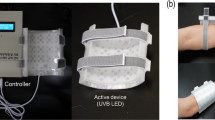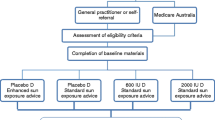Abstract
Purpose
Deficiency of vitamin D is very common in obese people and treatment by oral supplementation is not effective in all patients. This exploratory pilot study investigated the influence of different doses of short-term ultraviolet B irradiation on serum 25-hydroxyvitamin-D3 (25D) and 1,25-dihydroxyvitamin-D3 (1,25D) levels in obese compared to normal weight subjects and obese controls.
Methods
Participants with skin types II and III (Fitzpatrick skin classification) were assigned to six groups including four intervention groups receiving irradiation (three groups of obese and one group of normal weight subjects) and two control groups without treatment (obese and normal weight). Intervention groups received three sessions of whole body UVB irradiation of three different doses (cumulative doses over three sessions: 0.28, 0.70, 1.75 minimal erythema dose) within 1 week of intervention. Serum 25D and 1,25D were measured at baseline and after irradiation. Outcome differences between groups were analyzed using a linear model.
Results
Serum 25D levels increased significantly in obese (+23.6 and +26.7%, respectively, p = 0.01) and normal weight (+15.6%, p = 0.02) intervention groups who received medium and high doses of ultraviolet B irradiation compared to control groups (+3.5 and −4.0%, respectively, p = 1.0). The increase in obese patients was 51.4% greater compared to normal weight controls irradiated with equal ultraviolet B doses. Low-level ultraviolet irradiation did not result in a significant change in serum 25D (+7.0%, p = 0.61). We did not detect any significant differences of 1,25D between groups (p = 0.25).
Conclusions
The current study indicates that short-term ultraviolet B irradiation increases 25D levels in obese patients.


Similar content being viewed by others
References
WHO. Global Health Risks: Mortality and Burden of Disease Attributable to Selected Major Risks. (World Health Organization, Geneva, 2009)
C. Palacios, L. Gonzalez, Is vitamin D deficiency a major global public health problem? J. Steroid. Biochem. Mol. Biol. 144A, 138–145 (2014). doi:10.1016/j.jsbmb.2013.11.003
C.J. Murray, T. Vos, R. Lozano, M. Naghavi, A.D. Flaxman, C. Michaud et al., Disability-adjusted life years (DALYs) for 291 diseases and injuries in 21 regions, 1990-2010: a systematic analysis for the global burden of disease study 2010. Lancet. 380(9859), 2197–2223 (2012). doi:10.1016/S0140-6736(12)61689-4
E. Kamycheva, R.M. Joakimsen, R. Jorde, Intakes of calcium and vitamin d predict body mass index in the population of Northern Norway. J. Nutr. 133(1), 102–106 (2003)
D. Daniel, P. Hardigan, N. Bray, D. Penzell, C. Savu, The incidence of vitamin D deficiency in the obese: a retrospective chart review. J Community Hosp Intern Med Perspect 5(1), 26069 (2015). doi:10.3402/jchimp.v5.26069
H.F. DeLuca, Overview of general physiologic features and functions of vitamin D. Am. J. Clin. Nutr. 80(6 Suppl), 1689S–1696S (2004)
K.S. Vimaleswaran, D.J. Berry, C. Lu, E. Tikkanen, S. Pilz, L.T. Hiraki et al., Causal relationship between obesity and vitamin D status: bi-directional Mendelian randomization analysis of multiple cohorts. PLoS. Med. 10(2), e1001383 (2013). doi:10.1371/journal.pmed.1001383
A. Blann, An update on vitamin D deficiency and at risk groups. J Fam Health 25(3), 16–19 (2015)
M.F. Holick, Vitamin D deficiency. N. Engl. J. Med. 357(3), 266–281 (2007). doi:10.1056/NEJMra070553
K.A. Kennel, M.T. Drake, D.L. Hurley, Vitamin D deficiency in adults: when to test and how to treat. Mayo. Clin. Proc. 85(8), 752–757 (2010). doi:10.4065/mcp.2010.0138. quiz 757-758
K. vinh quoc Lu’o’ng, L.T. Nguyen, The beneficial role of vitamin D in obesity: possible genetic and cell signaling mechanisms. Nutr. J. 12, 89 (2013). doi:10.1186/1475-2891-12-89
S. Vanlint, Vitamin D and obesity. Nutrients 5(3), 949–956 (2013). doi:10.3390/nu5030949
L. Wamberg, T. Christiansen, S.K. Paulsen, S. Fisker, P. Rask, L. Rejnmark et al., Expression of vitamin D-metabolizing enzymes in human adipose tissue—the effect of obesity and diet-induced weight loss. Int. J. Obes. 37(5), 651–657 (2013). doi:10.1038/ijo.2012.112
H. Florez, R. Martinez, W. Chacra, N. Strickman-Stein, S. Levis, Outdoor exercise reduces the risk of hypovitaminosis D in the obese. J. Steroid. Biochem. Mol. Biol. 103(3–5), 679–681 (2007). doi:10.1016/j.jsbmb.2006.12.032
A.T. Drincic, L.A. Armas, E.E. Van Diest, R.P. Heaney, Volumetric dilution, rather than sequestration best explains the low vitamin D status of obesity. Obesity 20(7), 1444–1448 (2012). doi:10.1038/oby.2011.404
J. Wortsman, L.Y. Matsuoka, T.C. Chen, Z. Lu, M.F. Holick, Decreased bioavailability of vitamin D in obesity. Am. J. Clin. Nutr. 72(3), 690–693 (2000)
M.F. Holick, Sunlight, UV-radiation, vitamin D and skin cancer: how much sunlight do we need? Adv. Exp. Med. Biol. 624, 1–15 (2008). doi:10.1007/978-0-387-77574-6_1
R.S. Mason, V.B. Sequeira, C. Gordon-Thomson, Vitamin D: the light side of sunshine. Eur. J. Clin. Nutr. 65(9), 986–993 (2011). doi:10.1038/ejcn.2011.105
M.F. Holick, Vitamin D: a D-Lightful health perspective. Nutr. Rev. 66(10 Suppl 2), S182–194 (2008). doi:10.1111/j.1753-4887.2008.00104.x
W. Saliba, O. Barnett-Griness, G. Rennert, The relationship between obesity and the increase in serum 25(OH)D levels in response to vitamin D supplementation. Osteoporosis. Int. 24(4), 1447–1454 (2013). doi:10.1007/s00198-012-2129-0
S. Shah, D.M. Wilson, L.K. Bachrach, Large doses of vitamin D fail to increase 25-hydroxyvitamin D levels or to alter cardiovascular risk factors in obese adolescents: a pilot study. J. Adolesc. Health. 57(1), 19–23 (2015). doi:10.1016/j.jadohealth.2015.02.006
P. Kaur, S.K. Mishra, A. Mithal: Vitamin D toxicity resulting from overzealous correction of vitamin D deficiency. Clin Endocrinol (2015). doi:10.1111/cen.12836
P.J. Veugelers, T.M. Pham, J.P. Ekwaru, Optimal vitamin D supplementation doses that minimize the risk for both low and high serum 25-Hydroxyvitamin D concentrations in the general population. Nutrients 7(12), 10189–10208 (2015). doi:10.3390/nu7125527
J.N. Hathcock, A. Shao, R. Vieth, R. Heaney, Risk assessment for vitamin D. Am. J. Clin. Nutr. 85(1), 6–18 (2007)
R.P. Heaney, K.M. Davies, T.C. Chen, M.F. Holick, M.J. Barger-Lux, Human serum 25-hydroxycholecalciferol response to extended oral dosing with cholecalciferol. Am. J. Clin. Nutr. 77(1), 204–210 (2003)
R. Joshi, Hypercalcemia due to hypervitaminosis D: report of seven patients. J. Trop. Pediatr. 55(6), 396–398 (2009). doi:10.1093/tropej/fmp020
R. Rodriguez, M. Heras, M.J. Fernandez Reyes, R. Sanchez, [Renal failure as a result of vitamin D intoxication in an elderly patient due a therapeutic misunderstanding]. Rev. Esp. Geriatr. Gerontol. 45(4), 242–243 (2010). doi:10.1016/j.regg.2010.03.002
A. Marosz, D. Chlubek, The risk of abuse of vitamin supplements. Ann. Acad. Med. Stetin. 60(1), 60–64 (2014)
M.B. Smith, H.T. May, T.L. Blair, J.L. Anderson, J. Muhlestein, B.D. Horne, et al. Vitamin D excess is significantly associated with risk of atrial fibrillation. Paper presented at the American Heart Association 2011 Meeting in Orlande, Florida, U.S. (2011)
Z. Lagunova, A.C. Porojnicu, L. Aksnes, M.F. Holick, V. Iani, O.S. Bruland et al., Effect of vitamin D supplementation and ultraviolet B exposure on serum 25-hydroxyvitamin D concentrations in healthy volunteers: a randomized, crossover clinical trial. Br. J. Dermatol. 169(2), 434–440 (2013). doi:10.1111/bjd.12349
T.B. Fitzpatrick, The validity and practicality of sun-reactive skin types I through VI. Arch. Dermatol. 124(6), 869–871 (1988)
J.A. MacLaughlin, R.R. Anderson, M.F. Holick, Spectral character of sunlight modulates photosynthesis of previtamin D3 and its photoisomers in human skin. Science 216(4549), 1001–1003 (1982)
W.G. Tsiaras, M.A. Weinstock, Factors influencing vitamin D status. Acta. Derm. Venereol. 91(2), 115–124 (2011). doi:10.2340/00015555-0980
J.C. Dowdy, R.M. Sayre, M.F. Holick, Holick’s rule and vitamin D from sunlight. J. Steroid. Biochem. Mol. Biol. 121(1-2), 328–330 (2010). doi:10.1016/j.jsbmb.2010.04.002
F. Prodam, S. Zanetta, R. Ricotti, A. Marolda, E. Giglione, A. Monzani et al., Influence of ultraviolet radiation on the association between 25-Hydroxy vitamin D levels and cardiovascular risk factors in obesity. J. Pediatr. 171, 83–89 e81 (2016). doi:10.1016/j.jpeds.2015.12.032
B.f. Strahlenschutz: UV index worldwide. http://www.bfs.de/EN/topics/opt/uv/index/worldwide/worldwide.html (2015). Accessed 23 Aug 2015
S.Y. Shin, M.J. Kwon, J. Song, H. Park, H.Y. Woo, Measurement of serum total vitamin D (25-OH) using automated immunoassay in comparison [corrected] with liquid chromatography tandem-mass spectrometry. J. Clin. Lab. Anal. 27(4), 284–289 (2013). doi:10.1002/jcla.21598
A. Field. Discovering Statistics Using SPSS. (SAGE Puplications Ltd, London, 2005)
G.J. Van Breukelen, ANCOVA versus change from baseline: more power in randomized studies, more bias in nonrandomized studies [corrected]. J. Clin. Epidemiol. 59(9), 920–925 (2006). doi:10.1016/j.jclinepi.2006.02.007
F. Faul, E. Erdfelder, A.G. Lang, A. Buchner, G*Power 3: a flexible statistical power analysis program for the social, behavioral, and biomedical sciences. Behav. Res. Methods. 39(2), 175–191 (2007)
R.J. Sage, H.W. Lim, UV-based therapy and vitamin D. Dermatol. Ther. 23(1), 72–81 (2010). doi:10.1111/j.1529-8019.2009.01292.x
E. Thieden, H.L. Jorgensen, N.R. Jorgensen, P.A. Philipsen, H.C. Wulf, Sunbed radiation provokes cutaneous vitamin D synthesis in humans—a randomized controlled trial. Photochem. Photobiol. 84(6), 1487–1492 (2008). doi:10.1111/j.1751-1097.2008.00372.x
F. Stewart, A. Avenell: Behavioural Interventions for severe obesity before and/or after bariatric surgery: a systematic review and meta-analysis. Obesity Surgery (2015). doi:10.1007/s11695-015-1873-6
V. Bacci, G. Silecchia, Vitamin D status and supplementation in morbid obesity before and after bariatric surgery. Expert. Rev. Gastroenterol. Hepatol. 4(6), 781–794 (2010). doi:10.1586/egh.10.69
O. Engelsen, The relationship between ultraviolet radiation exposure and vitamin D status. Nutrients 2(5), 482–495 (2010). doi:10.3390/nu2050482
G. Jones, D.E. Prosser, M. Kaufmann, Cytochrome P450-mediated metabolism of vitamin D. J. Lipid. Res. 55(1), 13–31 (2014). doi:10.1194/jlr.R031534
J. Reichrath, B. Nurnberg, Cutaneous vitamin D synthesis versus skin cancer development: The Janus faces of solar UV-radiation. Dermatoendocrinol. 1(5), 253–261 (2009)
Acknowledgements
The authors would like to thank the staff of the medical photobiology group and the psychosomatic inpatient clinic at the Department of Psychosomatic Medicine at Charité—Universitätsmedizin Berlin, as well as all participants of this study. Charité University Funding.
Author information
Authors and Affiliations
Corresponding author
Ethics declarations
Conflict of interest
The authors declare that they have no competing interest.
Ethical approval
All procedures performed in studies involving human participants were in accordance with the ethical standards of the institutional and/or national research committee and with the Helsinki declaration of 1975 and its later amendments or comparable ethical standards.
Informed consent
Informed consent was obtained from all individual participants included in the study.
Electronic supplementary material
Rights and permissions
About this article
Cite this article
Obbarius, A., Berger, H., Stengel, A. et al. Short-term UVB irradiation significantly increases vitamin D serum concentration in obese patients: a clinical pilot study. Endocrine 56, 186–195 (2017). https://doi.org/10.1007/s12020-017-1252-2
Received:
Accepted:
Published:
Issue Date:
DOI: https://doi.org/10.1007/s12020-017-1252-2




